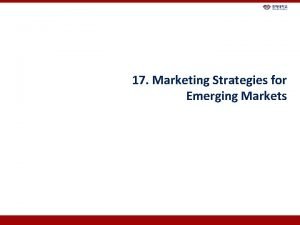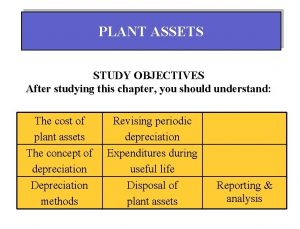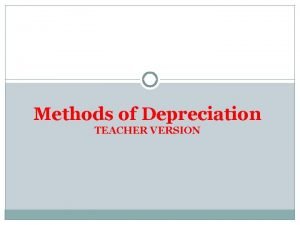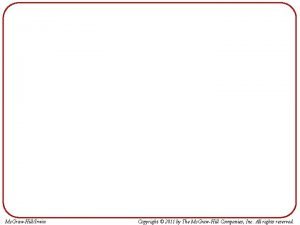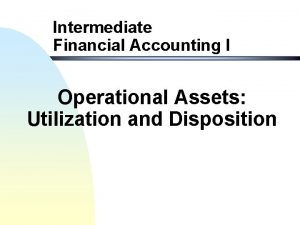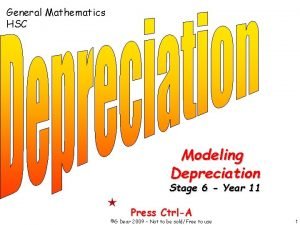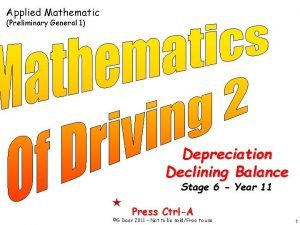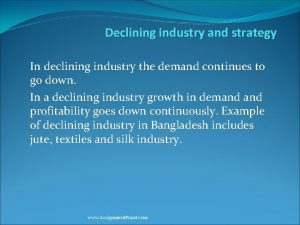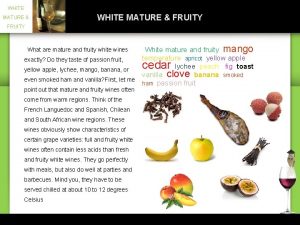Chapter 16 Strategies for Mature and Declining Markets

























- Slides: 25

Chapter 16 Strategies for Mature and Declining Markets Mc. Graw-Hill/Irwin Copyright © 2013 by The Mc. Graw-Hill Companies, Inc. All rights reserved.

Strategic Choices in Mature Markets It is not always easy to tell when a market has reached maturity Variations in brands, marketing programs, and customer groups can mean that different brands and market segments reach maturity at different times 16 -2

Strategic Choices in Mature Markets As the maturity stage progresses, a variety of threats and opportunities can disrupt an industry’s stability: Shifts in customer needs or preferences Product substitutes Increased raw material costs Changes in government regulations The entry of low-cost producers Mergers and acquisitions 16 -3

Strategic Choices in Mature Markets Success in mature markets requires two sets of strategic actions: The development of a well-implemented business strategy to sustain a competitive advantage, customer satisfaction, and loyalty Flexible and creative marketing programs geared to pursue growth or profit opportunities as conditions change in specific product-markets 16 -4

Strategies for Maintaining Competitive Advantage Both analyzer and defender strategies may be appropriate for units with a leading, or at least a profitable, share of one or more major segments in a mature industry Analyzer - Appropriate for developed industries that are still experiencing some technological change and may have opportunities for continued growth Defender - Works where the basic technology is not very complex or is unlikely to change dramatically 16 -5

Strategies for Maintaining Competitive Advantage Both analyzers and defenders can attempt to sustain a competitive advantage in established productmarkets: Through differentiation of their product offering By maintaining a low-cost position 16 -6

Exhibit 16. 1 - The Process of Customer Value Management 16 -7

Methods of Differentiation Dimensions of product quality: Functional performance Durability Conformance with specifications Variety of features Reliability Serviceability Fit and finish Quality reputation of the brand name Equity 16 -8

Methods of Differentiation Dimensions of service quality: Tangibles Reliability Responsiveness Empathy Assurance 16 -9

Are the Dimensions the Same for Service Quality on the Internet? Online service quality - The extent to which a website facilitates efficient and effective shopping, purchasing, and delivery 16 -10

Exhibit 16. 4 - Determinants of Perceived Service Quality 16 -11

Methods of Maintaining a Low-Cost Position Means for obtaining a sustainable cost advantage: A no-frills product Innovative product design Cheaper raw materials Innovative production processes Low-cost distribution Reductions in overhead 16 -12

Customers’ Satisfaction and Loyalty are Crucial for Maximizing Their Lifetime Value Measuring customer satisfaction To gain the knowledge necessary to continually improve the value of their offerings to customers, firms must understand how satisfied existing and potential customers are with their current offerings Improving customer retention and loyalty This is especially true as markets mature because loyal customers become more profitable over time 16 -13

Customers’ Satisfaction and Loyalty are Crucial for Maximizing Their Lifetime Value Are all customers equally valuable? The ability of firms to tailor different levels of service and benefits to different customers based on each person’s potential to produce a profit has been facilitated by the growing popularity of the Internet Increased stratification of consumer society: This raises ethical and strategic questions 16 -14

Chapter 17 Organizing and Planning for Effective Implementation Mc. Graw-Hill/Irwin Copyright © 2013 by The Mc. Graw-Hill Companies, Inc. All rights reserved.

Marketing Plans: The Foundation for Implementing Marketing Actions Preparation of a written plan is a key step in ensuring the effective execution of a strategic marketing program because it spells out what actions are to be taken, when, and by whom 16 -16

Exhibit 17. 8 - Contents of an Annual Marketing Plan 16 -17

The Situational Analysis Market situation - Data are presented on the target market Competitive situation - Identifies and describes the product’s major competitors in terms of their size, market share, product quality, marketing strategies, and other relevant factors Macroenvironmental situation - Describes broad environmental occurrences or trends that may have a bearing on the product’s future 16 -18

The Situational Analysis Past product performance - Discusses the product’s performance on such dimensions as sales volume, margins, marketing expenditures, and profit contribution for several recent years Sales forecast and other key assumptions - Typically includes estimates of sales potential, sales forecasts, and other evidence or assumptions underlying the plan 16 -19

Key Issues After analyzing the current situation, the product manager must identify the most important issues facing the product in the coming year These issues typically represent either threats to the future market or financial performance of the product or opportunities to improve those performances 16 -20

Objectives Financial objectives: Provide goals for the overall performance of the brand should reflect the objectives for the SBU as a whole and its competitive strategy Marketing objectives: Specify the changes in customer behavior and levels of performance of various marketing program elements necessary to reach the product’s financial objectives 16 -21

Marketing Strategy The manager must now specify the overall marketing strategy to be pursued The chosen strategy should fit the market and competitive conditions faced by the product and its strategic objectives It should also incorporate all of the necessary decisions concerning the 4 Ps 16 -22

Action Plans The most crucial part of the annual marketing plan for ensuring proper execution The specific actions necessary to implement the strategy for the product are listed, together with a clear statement of Who is responsible for each action When it will be done And how much is to be spent on each activity Specific timelines and milestones are set forth 16 -23

Projected Profit-and-Loss Statement The action plan includes a supporting budget that is essentially a projected profit-and-loss statement This budget is then presented to higher levels of management for review and possible modification Once approved, the budget serves as a basis for the plans and resource allocation decisions of other functional departments within the SBU 16 -24

Contingency Plans The manager might also detail contingency plans to be implemented if specific threats or opportunities should occur during the planning period 16 -25
 Strategies for mature and declining markets
Strategies for mature and declining markets Bypass attack strategy
Bypass attack strategy Mature market strategies
Mature market strategies Strategies for reaching global markets
Strategies for reaching global markets Strategies for competing in international markets
Strategies for competing in international markets Marketing strategies for emerging markets
Marketing strategies for emerging markets Making invitations dialogues
Making invitations dialogues Valuing distressed and declining companies
Valuing distressed and declining companies Susan strange the declining authority of states
Susan strange the declining authority of states Chapman university declining balance
Chapman university declining balance Units of activity method
Units of activity method Double declining method depreciation
Double declining method depreciation Reduced balance method
Reduced balance method Activity based method depreciation
Activity based method depreciation Double declining depreciation method
Double declining depreciation method Double declining balance method formula
Double declining balance method formula Macrs schedule
Macrs schedule Tangible long lived assets
Tangible long lived assets Double declining depreciation method
Double declining depreciation method Units of activity method
Units of activity method Informal reply letter format
Informal reply letter format Declining balance method formula hsc
Declining balance method formula hsc Declining balance method formula hsc
Declining balance method formula hsc Chapman panther partner
Chapman panther partner Partial year depreciation
Partial year depreciation The declining market for secrets
The declining market for secrets





